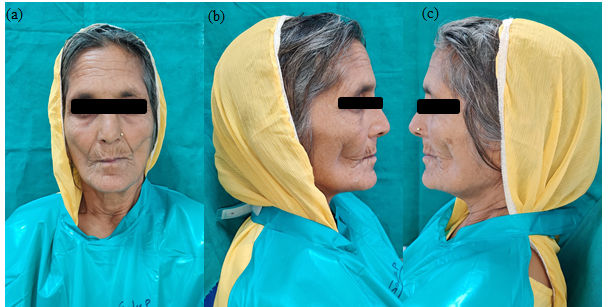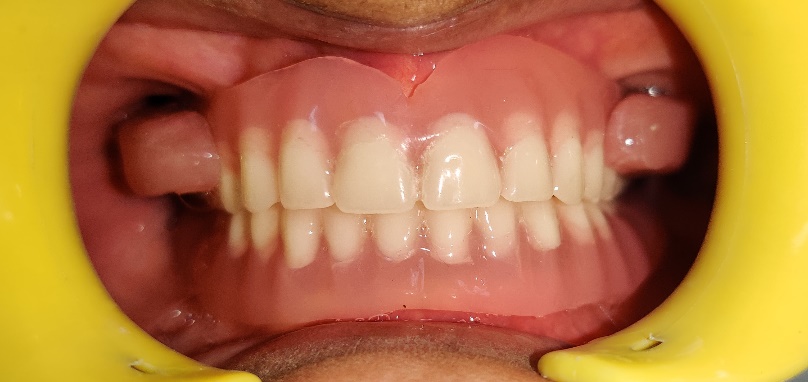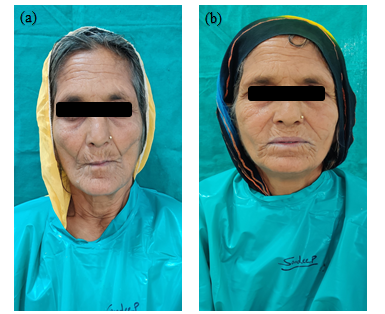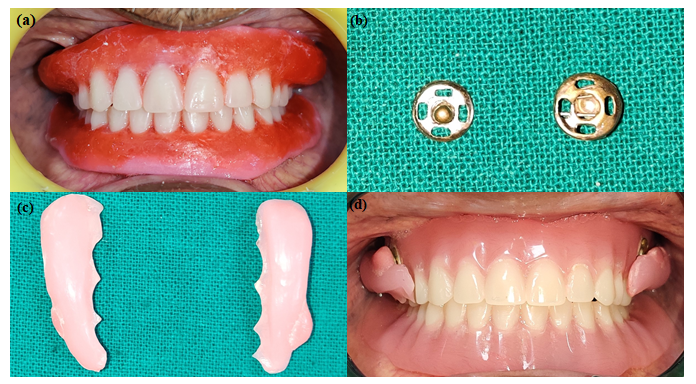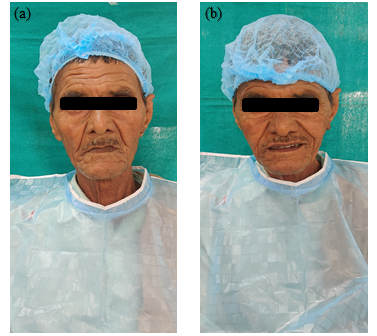Introduction
Prosthetic rehabilitation of an edentulous geriatric patient is not just limited to replacement of missing teeth. Every prosthesis should replace both function and aesthetics.1 Shape of cheeks is governed by the support provided by internal structures—teeth, alveolar processes, muscle tonicity and dentures. Extraction of posterior teeth, resorbed alveolar ridges, decreased muscle tonicity due to aging, weight loss and many systemic diseases can cause depressions below the zygomatic bone or hollow cheeks.2
Conventional complete dentures with properly positioned teeth and correct flange extensions adequately support the overlying lips and cheeks. However, in individuals with severe resorption of the alveolar process, conventional dentures fail to provide adequate support, requiring additional support for the cheeks. This can be accomplished by using cheek plumper or cheek lifting prosthesis.3
A conventional cheek plumper is a single unit prosthesis that increase the weight of the denture and increases the mesiodistal width of the prosthesis, thereby making its insertion difficult and its long-term use can cause muscle fatigue. Thus, to overcome this situation, a detachable cheek plumper can be fabricated. The present clinical case series describes different techniques of fabrication of detachable maxillary cheek plumper prosthesis in completely edentulous geriatric patients.
Case Report 1
A 60-year-old female patient reported to the Department of Prosthodontics, with the chief complaint of difficulty in chewing food due to missing upper and lower teeth and poor facial profile due to sunken cheeks. On intraoral examination, the patient had completely edentulous maxillary and mandibular arches. Extraoral examination revealed slumping of cheeks (Figure 1). Patient was unhappy due to esthetic problems of sunken and sagging of cheeks. Based on patient’s chief complaint and intraoral and extraoral examination, fabrication of maxillary and mandibular complete dentures with magnet-retained, detachable cheek plumpers attached to the maxillary denture was planned.
Primary impressions of upper and lower arches were made using impression compound (Pinnacle Impression Compound; Dental Products of India). Border moulding and secondary impression was carried out in the conventional manner. Maxillomandibular jaw relation was recorded followed by mounting of maxillary and mandibular cast, teeth arrangement and try-in was done (Figure 2).
Figure 2
(a) Primary Impression, (b) Secondary Impression (c) Maxillomandibular relation, (d) Try-in with wax cheek plumper
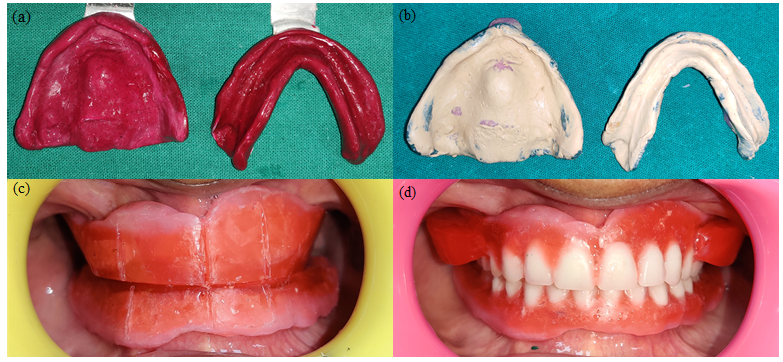
During try-in, cheek plumpers were made using modelling wax and were attached over the buccal flange of the maxillary denture in the premolar molar area. The plumpers were inspected extraorally for adequate cheek support, contour and interference with functional movements. After flasking and dewaxing, cured denture and cheek plumpers were retrieved, trimmed, finished, and polished. Two 1.5mm deep and 8mm diameter holes on either side were made on the buccal flanges of the maxillary denture and corresponding area of cheek plumpers. Neodymium–iron–boron intra oral magnets (Nd–Fe–B) of same dimension were sealed with autopolymerising acrylic resin on the buccal flange of maxillary denture (Figure 3).
Figure 3
(a) Neodymium–iron–boron intra oral magnets (Nd–Fe–B); (b) Magnets sealed with autopolymerising acrylic resin

Magnets sealed with autopolymerising acrylic resin
Retentive force of intraoral magnet was measured using dontrix guage and Nd-Fe-B magnets was found to withstand force upto 9 ounces (252 gm). Final denture was delivered and instructions regarding attachment and detachment of cheek plumpers were given(Figure 4).
Case Report 2
A 65-year-old male patient with similar intraoral and extraoral finding as in case 1 reported to the Department. Since the patient was seeking improvement in his facial appearance, fabrication of maxillary and mandibular complete dentures with Press button retained, detachable cheek plumpers attached to the maxillary denture was planned.
All the steps till teeth arrangement were done similar to case 1. During try-in stage, wax cheek plumpers were attached to the maxillary denture and checked for support, contour and interference with functional movements. After curing of denture and cheek plumpers, two 1.5mm deep and 8mm diameter holes on either side were made on the buccal flanges of the maxillary denture and corresponding area of cheek plumpers. Press button with male and female counterpart of same dimension were sealed with autopolymerising acrylic resin on the buccal flange of maxillary denture. Retentive force of press button retained cheek plumper was measured using dontrix guage and press button was found to withstand force upto 6 ounces (168 gm). Instructions regarding attachment and detachment of cheek plumpers were given.
Discussion
Teeth have a beauty of their own and also, they have tremendous impact on one’s overall personality. Teeth and adjacent oral structures have frequently been modified to enhance esthetics, and to indicate a position of eminence. The personality and esthetics is important not only in young individuals but, also in geriatric patients. In old age, due to number of factors, slumping of cheeks can occur, which not only affects the facial appearance but also affects the patient’s psychology and social life.
Non-surgical rejuvenation procedures such as botulinum toxin (BTX) and dermal filler injections are also available as treatment options for sunken cheeks. When injected into facial folds or creases, the filler produces a “plumping effect” that softens wrinkles and creates a fuller and smoother complexion. However, they have adverse effects such as pain, hypersensitivity, anaphylaxis, swelling, erythema, infection, overcorrection, necrosis and the results are temporary lasting for maximum 6 months.4
Complete denture prosthesis can aid in supporting the slumped cheeks. Conventional methods include increasing thickness of flange of maxillary and mandibular denture such that vestibular area is filled with adequate facial contours or arranging second row of teeth for esthetic reasons has been reported in the literature.5 These conventional cheek plumpers increase the weight and mesiodistal width of the prosthesis and cause interference with the functions of the masseter muscle and the coronoid process of the mandible and hence can destabilize the upper denture especially during chewing.
There are different types of attachments available to attach cheek plumper to maxillary denture. Dentists can choose the appropriate attachment according to the thickness and height of the denture flange and the dexterity of the patient.6 In first case, intra-oral magnets were used as an attachment. The main magnetic materials used in dentistry are rare earth material neodymium iron boron (Nd-Fe-B), RE alloy samarium cobalt (Sm-Co), Samarium iron nitride, Alnicos—alloys based on aluminium, cobalt and nickel and cobalt platinum (Co-Pt) magnets.7 In above case neodymium iron boron magnets are used as it is most powerful commercially available magnet material. Nd-Fe-B Magnet has strong wear resistance and corrosion resistance. Magnets have the benefit of easy cleaning, easy to remove and place, automatic reseating due to magnetic forces, simplicity of the clinical and laboratory procedures, and constant retentive force with the consecutive number of insertion and removal cycles.3
In second case, press buttons were used as an attachment. Press buttons have the benefit of being simple in design, cost effective, easily available and good retentive power. These are made up of stainless steel which has excellent corrosion resistance in oral cavity.
The drawbacks of cheek plumpers include the patient discomfort and muscle fatigue resulting from the increased weight of the dentures, food accumulation, the requirement of manual dexterity of patients to ensure accurate attachment, and the susceptibility of magnetic attachments to corrosion and loss of magnetism and of the press button to breakage. However, their esthetic benefits far outweigh the drawbacks. A periodic patient recall is therefore necessary to assess and, when required, replace the attachments.8
Conclusion
In geriatric patients with severe ridge resorption and sunken cheeks, cheek plumpers can transform the facial appearance and esthetics remarkably. Cheek plumpers are simple, scientific, easy to fabricate and provide a non-invasive and cost-effective treatment option for the improvement of facial appearance in geriatric patients with sunken cheeks. This treatment helps improve esthetics, self-image and the psychological well-being of patients.

